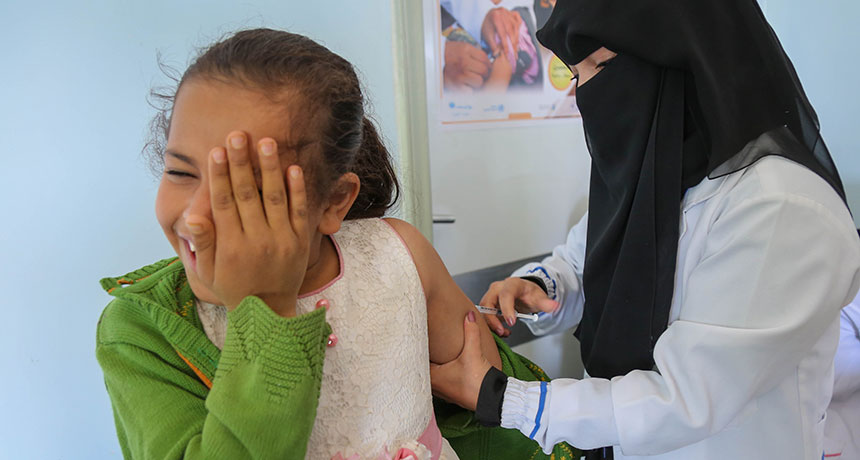U.S. measles cases hit a record high since the disease was eliminated in 2000
About 169 million kids worldwide didn’t get a measles shot in 2010–2017, easing disease spread

SHOT OF COURAGE A young girl in war-torn Yemen gets a measles shot as part of a UNICEF program aimed at boosting vaccination rates against the infectious disease.
Aidroos Alaidroos/© UNICEF
U.S. measles cases have soared to the highest number since the disease was declared eliminated in the country in 2000. The 2019 tally now stands at 695 cases, the U.S. Centers for Disease Control and Prevention reports. That surpasses the previous high of 667 cases in 2014.
“The high number of cases in 2019 is primarily the result of a few large outbreaks — one in Washington State and two large outbreaks in New York that started in late 2018,” according to a statement released by the CDC April 24. “The outbreaks in New York City and New York State are among the largest and longest lasting since measles elimination in 2000. The longer these outbreaks continue, the greater the chance measles will again get a sustained foothold in the United States.”
Years of inadequate childhood measles vaccination coverage throughout the world have set the stage for the resurgence in the United States as well as in many other countries. An estimated 169 million children globally were not vaccinated against measles from 2010 to 2017 — or an average of 21.1 million per year, according to data released April 24 by UNICEF to kick off World Immunization Week.
“It is unfortunate where we stand in 2019 on measles control, given the fact that we have such an effective, safe and, very importantly, inexpensive vaccine available,” says Robin Nandy, Chief of Immunization at UNICEF in New York City.
Among high-income countries, the United States tops the list of those with the largest numbers of kids who have not received the measles vaccine. UNICEF, the United Nations Children’s Fund, reports more than 2.5 million U.S. children went unvaccinated against the virus from 2010 to 2017. France has the next highest number, with more than 600,000 during those years, followed by the United Kingdom’s 527,000. The high U.S. and European numbers are explained mostly by parental resistance to vaccines (SN Online: 11/30/18).
“Measles is no longer only a problem of low-income countries or conflict-affected countries,” Nandy says. “It’s a risk everywhere.”
Around 91 percent of U.S. kids got at least one measles shot in 2017, according to the CDC. (Two are recommended for the highest amount of protection.) But that level of coverage isn’t consistent across the country, creating pockets of vulnerability. Widespread vaccination levels around 92 to 95 percent are needed to establish herd immunity against the virus and prevent outbreaks (SN Online: 4/15/19).
In developing countries, a failure to vaccinate usually comes down to a lack of vaccines or funding, logistical difficulty reaching rural areas or ongoing conflict. In 2017 alone, Nigeria had 4 million children who had missed the first dose of the measles vaccine by their first birthday. India had 2.9 million, while Pakistan and Indonesia each had 1.2 million.
Reported cases of measles worldwide were higher in the first three months of 2019, compared with the same period in 2018, according to the World Health Organization. As of the end of March, 170 countries had reported 112,163 cases of measles, preliminary data show. In comparison, WHO confirmed 89,482 cases for that same time period in 2018. Outbreaks are currently ongoing around the world, including in the United States, Israel, the Philippines, the Congo, Ethiopia, Madagascar and Ukraine.
Editor’s note: This story was updated April 25, 2019, to include the latest tally of U.S. measles cases from the U.S. Centers for Disease Control and Prevention.







